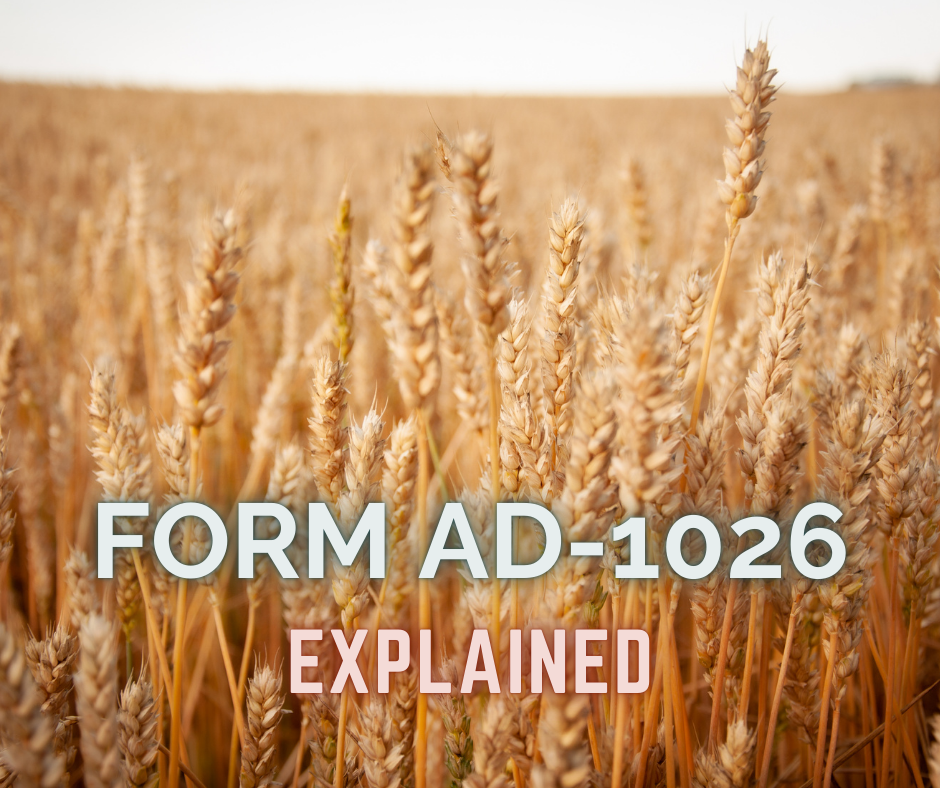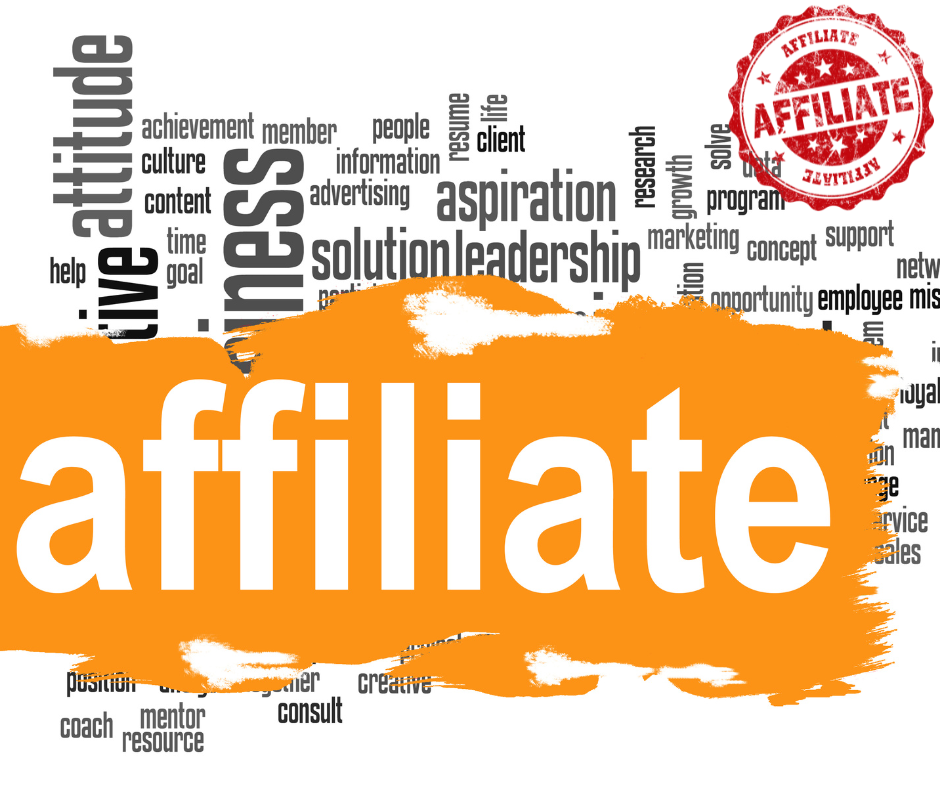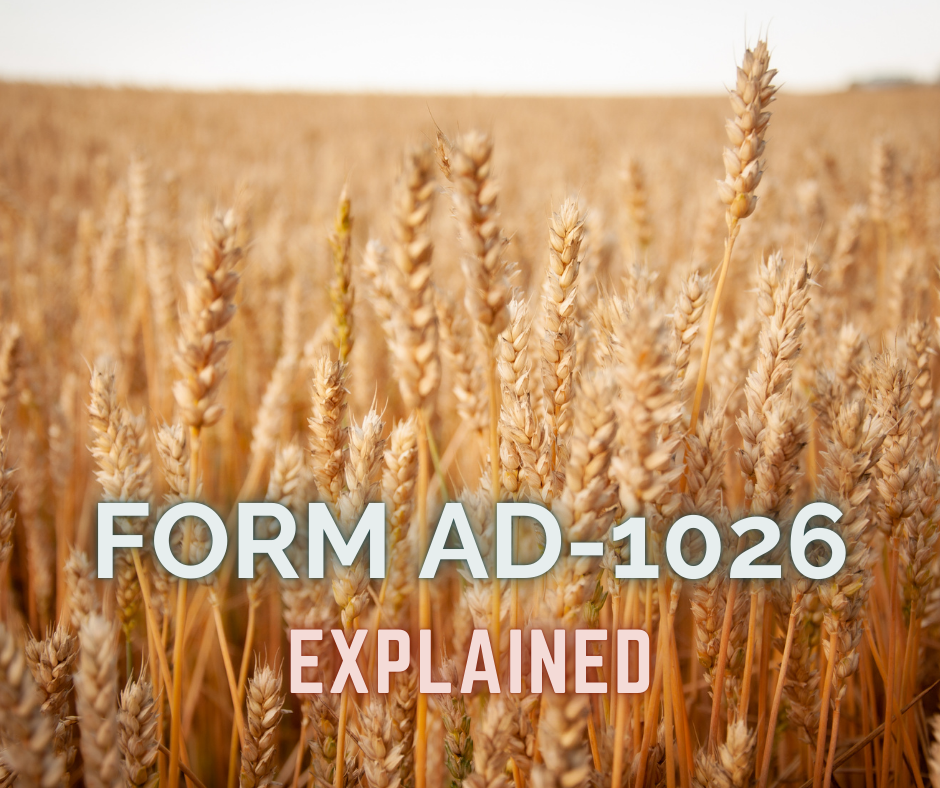What is the Form AD-1026

The Conservation Certification
Form AD-1026, officially known as the Highly Erodible Land Conservation (HELC) and Wetland Conservation (WC) Certification, is a document for farmers and livestock producers seeking USDA benefits
This document is used to certify compliance with conservation requirements, which is required for eligibility in various USDA programs
The form is administered by the Farm Service Agency (FSA) which is a division of the USDA
Why Does the Form AD-1026 Exist?

Because…… Government Said So!
Form AD-1026 exists due to the Food Security Act of 1985
This Act requires producers to comply with Highly Erodible Land Conservation (HELC) and Wetland Conservation (WC) provisions if they participate in most programs administered by:
- Farm Service Agency (FSA)
- Natural Resources Conservation Service (NRCS)
- Risk Management Agency (RMA)
These provisions apply to all land owned or farmed that is considered highly erodible or a wetland, unless the USDA determines an exemption applies
The requirements extend beyond just the producers themselves. Any individuals or entities considered to be affiliated persons of a participating producer are also subject to these provisions
The regulations governing these provisions are detailed in 7 CFR part 12. All such provisions, whether explicitly stated in the form or not, apply to participants
What are the Conditions of Eligibility?

Your Passport to Participation
To receive USDA loans or program benefits subject to Highly Erodible Land Conservation (HELC) and Wetland Conservation (WC) provisions, producers must meet certain conditions
These apply to all farms and Ranches in which the producer, and any affiliated persons (as defined in 7 CFR Part 12), have an interest, unless exempted by the USDA:
- Highly Erodible Land:
- Do not plant or produce agricultural commodities on highly erodible land unless following an NRCS-approved conservation plan
- Wetland Conservation:
- Do not plant or produce agricultural commodities on wetlands converted after December 23, 1985.
- Do not convert wetlands after November 28, 1990, to make agricultural production possible.
- Do not convert wetlands through draining, dredging, filling, leveling, or removing woody vegetation that would allow planting of agricultural commodities
- Use of USDA Funds:
- Do not use Farm Service Agency loan proceeds or any USDA financial assistance in ways that might negatively impact wetlands, except for NRCS-approved projects
These conditions seek to ensure that agricultural practices align with conservation efforts to protect both highly erodible lands and wetlands
What the Terms Mean

Hmm…The Aliens Haven’t Told Me Yet!
Form AD-1026 uses several specialized terms that could be misinterpreted. Here’s a clarification of some important terms:
Agricultural Commodity
- Any crop planted and produced by annual tilling of the soil
- Includes crops planted with one-trip planters
- Also includes sugarcane
Highly Erodible Land
- Land with an erodibility index of 8 or more
Highly Erodible Fields
- Fields where either:
- 33.33% or more of the total field acreage is identified as highly erodible soil map units, or
- 50 or more acres in the field are identified as highly erodible soil map units
Perennial Crop
- A crop planted once that produces over multiple years
Wetland
- An area that meets all of these criteria:
- Has a predominance of hydric (wet) soils
- Is sufficiently inundated or saturated by surface or groundwater to support water-tolerant vegetation
- Normally supports such vegetation
Exception: This doesn’t include Alaskan lands with high agricultural development potential and predominant permafrost soils
Who Makes The Decisions?

Who’s the Big Cheese Around These Parts?
NRCS and FSA share responsibilities for HELC and WC determinations, with NRCS handling compliance and FSA managing eligibility. Here’s the breakdown:
NRCS Responsibilities (Technical Determinations)
- For HELC Compliance:
- Identifying highly erodible land
- Establishing conservation plans or systems
- Verifying if highly erodible fields follow approved conservation plans
- For WC Compliance:
- Determining if land is a wetland and if technical exemptions apply
- Assessing whether wetland conversion has occurred
FSA Responsibilities
- Eligibility Determinations:
- Deciding who is ineligible based on NRCS non-compliance findings
- Handling requests for eligibility exemptions (e.g., good faith relief)
- Record Keeping:
- Maintaining official USDA records of highly erodible land and wetland determinations
- Recording determinations in the geographic information system and automated farm/tract records
Important Note: These determinations may not cover all of a producer’s land. If uncertain about any land determinations, producers should contact their local USDA Service Center for assistance.
What Happens When a Producer is Non-Compliant?

You’re in Trouble NOW!
Non-compliance with HELC and WC provisions can have serious consequences for producers:
Loss of Eligibility
- Non-compliant producers become ineligible for most FSA and NRCS program benefits.
- If benefits were received before non-compliance was discovered, producers may have to refund all benefits and/or pay penalties
Compliance Requirements
- Unless exemptions apply, producers must:
- Not plant or produce agricultural commodities on highly erodible fields without an NRCS-approved conservation plan.
- Avoid planting or producing on wetlands converted after December 23, 1985.
- Not convert wetlands for agricultural production after November 28, 1990
Duration of Ineligibility
- Violations result in ineligibility for the year(s) of the violation
- For planting violations (on highly erodible land or converted wetlands): Ineligibility begins in the year of conversion
Impact of HELC and WC Non-Compliance on FCIC Crop Insurance Policies

It’s a Carnival of Consequences!
Non-compliance with Highly Erodible Land Conservation (HELC) and Wetland Conservation (WC) provisions can significantly affect a producer’s eligibility for Federal Crop Insurance Corporation (FCIC) premium subsidies
What You Need to Know
- Eligibility Requirements:
- File a completed Form AD-1026 with FSA, certifying compliance with HELC and WC provisions
- Maintain compliance with HELC and WC provisions
- Conservation Obligations:
- Only produce agricultural commodities on highly erodible fields with an NRCS-approved conservation plan
- Avoid planting or producing on wetlands converted after February 7, 2014
- Refrain from converting wetlands for agricultural production after February 7, 2014
Consequences of Non-Compliance
- Loss of FCIC premium subsidies for all insurance policies in the following reinsurance year (July 1 – June 30)
- Ineligibility applies even during administrative appeals
- Failure to file Form AD-1026 by June 1 results in subsidy ineligibility for the upcoming reinsurance year
Verification Process
- Risk Management Agency (RMA) checks compliance status with FSA before each reinsurance year
- Non-compliant producers lose premium subsidies for all crops with sales closing dates between July 1 and June 30 of the following year
Producers should ensure their timely filing of Form AD-1026 and maintain compliance to avoid losing their crop insurance premium subsidies
Affiliated Persons

Conceptually, It’s A Bit of A Chameleon
Compliance with Highly Erodible Land Conservation (HELC) and Wetland Conservation (WC) provisions extends beyond the primary producer
Affiliated persons must also comply to ensure the primary producer’s eligibility for benefits.
So, who are these Affiliated Persons? Well, the definition varies based on the type of producer requesting benefits:
For Individual Producers
- Spouses or minor children with separate farming interests or individual benefit IDs
- Estates, trusts, partnerships, and joint ventures involving the individual, their spouse, or minor children
- Corporations where the individual, spouse, or minor children have over 20% interest
For Entities (General partnerships, LLCs, joint ventures, estates, trusts, Indian tribal ventures)
- First-level members of the entity
For Corporations
- First-level shareholders with more than 20% interest
- Note: Shareholders with 20% or less interest are not considered affiliated persons
Compliance Requirements for Affiliated Persons
- Must adhere to HELC and WC provisions
- Must file Form AD-1026 certifying compliance
Important: If an affiliated person is found non-compliant, it affects the primary producer’s eligibility for benefits
Remember: Any affiliated person with a farming interest (as owner, operator, or producer on any farm) must file Form AD-1026 to ensure the primary producer’s eligibility for benefits
Authorizing USDA Inspection

Eyes on You!
By signing Form AD-1026, producers are authorizing USDA representatives to enter and inspect all farms in which the producer (named in Part A of the form) has an interest
The purpose of these inspections is to confirm compliance with Highly Erodible Land Conservation (HELC) and Wetland Conservation (WC) provisions
This authorization is a required aspect of the certification process, allowing the USDA to verify that the information provided is accurate and that conservation practices are being properly implemented
Producers should be aware that this permission is a mandatory part of participating in USDA programs subject to HELC and WC provisions
A Final Point: When to Update Form AD-1026

From Vintage to Current!
Form AD-1026 doesn’t require annual completion however, certain situations call for revision:
- Changes in Farming Operations:
- Any alterations that might affect HELC and WC compliance
- New Activities:
- Planning or completing actions that could impact compliance, such as:
- Removing fence rows
- Conducting drainage activities
- Combining fields
- Planning or completing actions that could impact compliance, such as:
- Compliance Violations:
- Any HELC or WC violations that invalidate the previous AD-1026
Important Deadline
Submit revised AD-1026 by June 1 before the crop year starts (July 1) to maintain eligibility for USDA benefits, including crop insurance premium subsidies
Consistency Across USDA Agencies
- Information on AD-1026 should match data provided to other USDA agencies (e.g., RMA)
- The form serves as a unified compliance certification for all USDA programs
- FSA, NRCS, and RMA share this information to determine benefit eligibility
Remember: Keeping your AD-1026 up-to-date allows continued access to USDA program benefits
Armor Insurance Agency

If you liked this article you can find more here
What would be the ideal outcome for you?
Call: (406) 416-1096
We are an equal opportunity provider


Leave a Reply